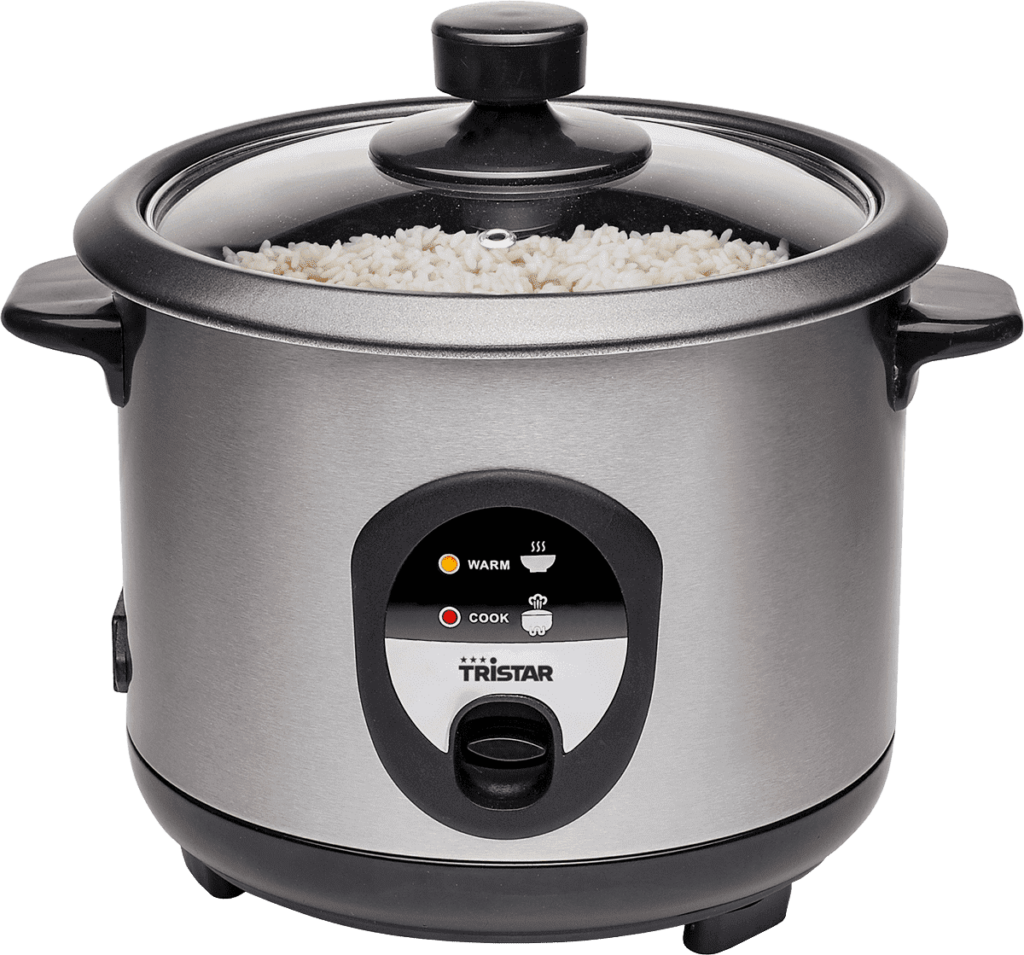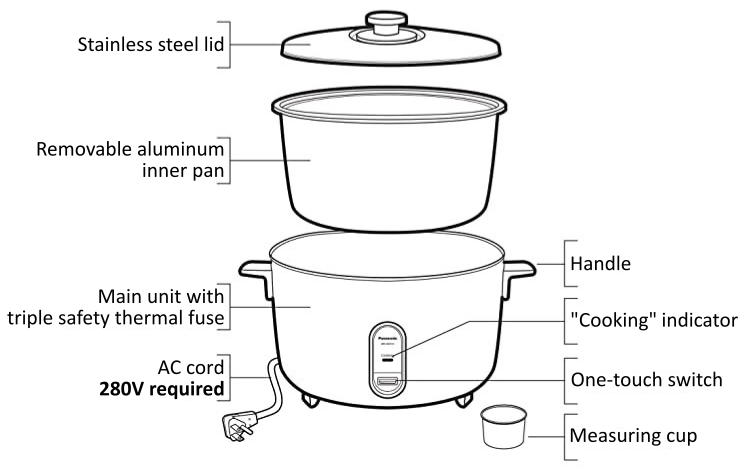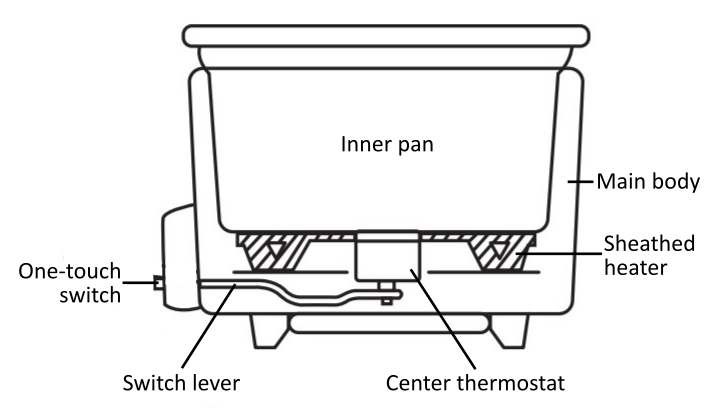By Adven Simarmata. Last updated on October 28th, 2023.

Broadly speaking, a rice cooker is a must-have appliance in households that use rice as their staple food, such as in many households in Asia. The invention of the automatic rice cooker tremendously helps lighten homemakers’ housework since cooking rice with an automatic rice cooker does not need constant attendance like the old method does. In 1955, Toshiba became the first company that successfully mass-produced automatic electric rice cookers in Japan.[1] This invention led to a “kitchen revolution” in Japan as many people started to replace their kamado with this life-changing appliance.[2]
As time goes by, Toshiba and other manufacturers improved their rice cookers, such as by inventing a more effective heating method, adding a “keep warm” mode, adding a timer, and designing the rice cooker to be multifunction. In this article, we will focus on discussing one of the most basic models of rice cooker that has been around since decades ago. This basic rice cooker has only one mechanical button, labeled as the “one-touch switch” in Figure 2, that switches between “cooking” and “keep warm” modes. This model uses a magnetic temperature sensor that tells the rice cooker to switch to “keep warm” mode after the rice is completely cooked. This basic model is much cheaper than the more advanced ones, but some people prefer this model to the more advanced ones because they like its simplicity. Besides that, this basic model cooks the rice as well as the more advanced models do.
This basic model that we will discuss is still on sale in the market, like the Panasonic SR-GA721. You can see the main components of this basic model in Figure 2.[3]

Working Principle of a Basic Automatic Rice Cooker
The steps to cook rice in this model is simple. Put water and rice with a ratio of about 2:1 into the inner pan. Insert the pan into the main body. Put the lid on, and then plug in the cord. In the resting position, the one-touch switch will be on the “keep warm” position. To start the cooking process, press the switch down, and the rice will start to be cooked inside the pan.
As the heater gives heat to the water, the temperature of the water constantly rises until it reaches 100℃. Once the water reaches 100 degrees Celsius, which is the boiling point of water, the water will start to evaporate, and the hot steam will cook the rice. During the evaporation, the temperature of the remaining liquid water will stay at 100℃. At this point, the heat from the heater is used by the water molecules as the energy source to break up and change their phase from liquid to gas. The heat absorbed by the water to evaporate is called the latent heat of vaporization. Only after all the water evaporates, the temperature of the rice can increase. When the temperature of the rice reaches a certain predetermined temperature, the magnetic temperature sensor beneath the pan switches the electrical circuit to be on the “keep warm” mode, signaling that the cooking process has finished.[4] Now, how does the magnetic center thermostat sense the temperature and tell the rice cooker to switch to “keep warm” mode?
Working Principle of the Magnetic Center Thermostat
The magnetic center thermostat is the heart of the automatic operation of the rice cooker. It is located at the bottom and center of the rice cooker, as you can see in Figure 3. It is attached to a lever that is connected to the one-touch switch. It is also connected to the “cooking” indicator lamp through electrical wiring.

The magnetic temperature sensor will be naturally pressed down by the weight of the inner pan that is inserted into the main body. The outer spring will be compressed; this signals that the inner pan has been properly placed, so it is safe to start the cooking process.

Figure 4 above shows the construction and positions of the magnetic center thermostat. The part that is labeled as “metal” is a soft magnetic material, e.g., the ferrite alloy.[5] This alloy is ferromagnetic, meaning that it becomes magnetized in a magnetic field and retains its magnetism when the field is removed. However, above a certain temperature, this alloy will lose its magnetism. And the temperature above which this alloy loses its ferromagnetism and becomes a paramagnet is called the Curie temperature. The Curie temperature of this alloy should be just above 100 degrees Celsius, which is the boiling point of water. The interesting ability a ferromagnet has is it will regain its magnetism after it cools down, unlike the permanent magnet that will permanently lose its magnetism once it reaches its Curie point. The heat from the inner pan is well conducted to the ferrite alloy, so the inner pan and the ferrite alloy have more or less the same temperature all the time.
The part that is labeled as “magnet” is a permanent magnet. At a cool temperature, the ferrite alloy will be attracted to this magnet. As the temperature of the inner pan rises, the temperature of the ferrite alloy also rises. When the temperature of the ferrite alloy reaches its Curie temperature, e.g. 90-105℃,[5] the ferrite alloy will lose its magnetism. As a result, the magnet and the ferrite alloy will be popped apart. In the Panasonic SR-GA721, the magnet and the soft magnetic metal will pop apart at the temperature of 134℃ ± 6℃.[3]
Since the attraction between the magnet and the ferrite alloy has weakened, the force of the inner spring pulls the magnet down. As a result, the rod that is connected to the magnet pushes the switch lever. And the switch lever presses the micro-switch button into the warming cycle.
The micro switch is also connected to the cooking indicator lamp through electrical wiring. When it is in the “cooking” cycle, the “cooking” lamp will be switched on. And when it is in the “keep warm” cycle, the lamp that is switched on is the “keep warm” lamp. And this is how the magnetic temperature sensor works on a rice cooker.
References
- Toshiba. (n.d.). Traditional Hagama Rice-cooking, Modernized. Retrieved March 29, 2023, from https://www.toshiba-lifestyle.com/jp/living/tourist/en/ricecooker.html
- Kids Web Japan. (n.d.). Rice Cookers – The Kitchen Revolution. Retrieved March 29, 2023, from https://web-japan.org/kidsweb/hitech/rice/rice01.html
- Panasonic. (2012, April). Service Manual – Automatic Rice Cooker. Retrieved March 29, 2023, from https://www.manualslib.com/download/2015290/Panasonic-Sr-Ga281.html
- Aoshima, T. (1982). U.S. Patent No. US4362923A. Washington, DC: U.S. Patent and Trademark Office. Retrieved March 29, 2023, from https://patents.google.com/patent/US4362923A/en
- 潘树明. (2007). U.S. Patent No. CN1899171A. Washington, DC: U.S. Patent and Trademark Office. Retrieved March 29, 2023, from https://patents.google.com/patent/CN1899171A/en

Leave a Reply